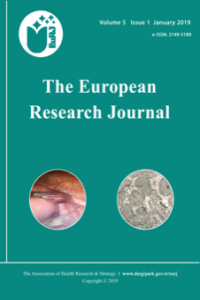Case Report
Year 2019,
Volume: 5 Issue: 1, 223 - 225, 04.01.2019
Abstract
References
- [1] Wolff K, Goldsmith LA, Katz SI, Gilchrest BA, Paller AS, Leffell DJ. Fitzpatrick's Dermatology in General Medicine.7th ed. The Mc Graw-Hill Company, Inc., 2008:632.
- [2] Radmanesh M. Naevus of Ota treatment with cryotherapy. J Dermatolog Treat 2001;12:205-9.
- [3] Ono I, Tateshita T. Efficacy of the ruby laser in the treatment of Ota's nevus previously treated using other therapeutic modalities. Plast Reconstr Surg 1998;102:2352-7.
- [4] Ho SG, Chan HH. The Asian dermatologic patient: review of common pigmentary disorders and cutaneous diseases. Am J Clin Dermatol 2009;10:153-68.
- [5] Kouba DJ, Fincher EF, Moy RL. Nevus of Ota successfully treated by fractional photothermolysis using a fractionated 1440-nm Nd:YAG laser. Arch Dermatol 2008;144:156-8.
- [6] Yongqian C, Li L, Jianhai B, Ran H, Li G, Hao W, et al. A split-face comparison of Q-switched Nd:Yag 1064-nm laser for facial rejuvenation in Nevus of Ota patients. Lasers Med Sci 2017;32:765-9.
- [7] Yan L, Di L,Weihua W, Feng L, Ruilian L, Jun Z, et al. A study on the clinical characteristics of treating nevus of Ota by QS Nd:YAG laser. Lasers Med Sci 2018;33:89-93.
Year 2019,
Volume: 5 Issue: 1, 223 - 225, 04.01.2019
Abstract
Nevus of Ota is a benign hamartoma which presenting as
blue-gray hyperpigmented patches on the face and mucous membranes usually
within the distribution of first and second branches of the trigeminal nerve. It
may occur at birth or during adolescence and the nevus of Ota is very common seen
in Japan and east countries. The pigmentation varies and can be dark brown to blue
to black-blue. We report a 31-year-old female patient with the nevus of Ota. The
Q-switched Nd:YAG laser, had a spot size of 3 mm, an 8 Hz repetition rate, 720 mj/cm2
fluence. The patient's lesion improved in a rate of 60% with a single session. The
Q-switched Nd:YAG laser has a significant effect in treating the nevus of Ota.
References
- [1] Wolff K, Goldsmith LA, Katz SI, Gilchrest BA, Paller AS, Leffell DJ. Fitzpatrick's Dermatology in General Medicine.7th ed. The Mc Graw-Hill Company, Inc., 2008:632.
- [2] Radmanesh M. Naevus of Ota treatment with cryotherapy. J Dermatolog Treat 2001;12:205-9.
- [3] Ono I, Tateshita T. Efficacy of the ruby laser in the treatment of Ota's nevus previously treated using other therapeutic modalities. Plast Reconstr Surg 1998;102:2352-7.
- [4] Ho SG, Chan HH. The Asian dermatologic patient: review of common pigmentary disorders and cutaneous diseases. Am J Clin Dermatol 2009;10:153-68.
- [5] Kouba DJ, Fincher EF, Moy RL. Nevus of Ota successfully treated by fractional photothermolysis using a fractionated 1440-nm Nd:YAG laser. Arch Dermatol 2008;144:156-8.
- [6] Yongqian C, Li L, Jianhai B, Ran H, Li G, Hao W, et al. A split-face comparison of Q-switched Nd:Yag 1064-nm laser for facial rejuvenation in Nevus of Ota patients. Lasers Med Sci 2017;32:765-9.
- [7] Yan L, Di L,Weihua W, Feng L, Ruilian L, Jun Z, et al. A study on the clinical characteristics of treating nevus of Ota by QS Nd:YAG laser. Lasers Med Sci 2018;33:89-93.
There are 7 citations in total.
Details
| Primary Language | English |
|---|---|
| Subjects | Health Care Administration |
| Journal Section | Case Reports |
| Authors | |
| Publication Date | January 4, 2019 |
| Submission Date | February 8, 2018 |
| Acceptance Date | August 18, 2018 |
| Published in Issue | Year 2019 Volume: 5 Issue: 1 |
e-ISSN: 2149-3189
The European Research Journal, hosted by Turkish JournalPark ACADEMIC, is licensed under a Creative Commons Attribution-NonCommercial-NoDerivatives 4.0 International License.

2025


